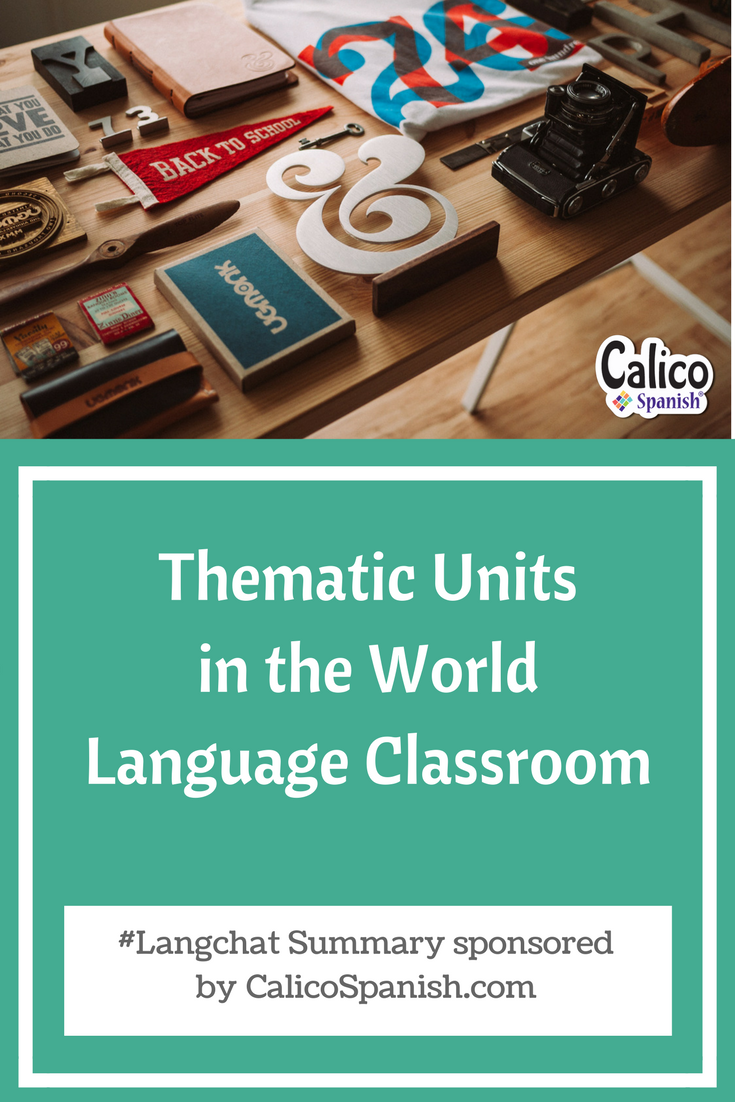Thematic Units in the World Language Classroom
 Last week’s #langchat focused on how to incorporate thematic units in the world language classroom. Participants discussed inspiration for successful themes, prioritizing structures and vocabulary, and integrating instructional elements and assessments into successful thematic language lessons.
Last week’s #langchat focused on how to incorporate thematic units in the world language classroom. Participants discussed inspiration for successful themes, prioritizing structures and vocabulary, and integrating instructional elements and assessments into successful thematic language lessons.
– Follow the blog on Bloglovin –
Inspiration for Successful Themes
#Langchat teachers have found inspiration for successful themes through a variety of sources. It is often important for teachers to get creative and think outside of the box when determining thematic units for the world language classroom. @dressurleben shared, “Lately I’ve been finding inspiration from my students’ other classes, trying out the interdisciplinary support angle.” Many #langchat teachers agreed that “looking at AP themes and sub themes” proved to be successful sources for thematic content (@bjillmoore). Also, it is helpful to take a deeper look at student life while asking “what are their interests at each level?” (@bjillmoore). @SraWienhold said, “I find inspiration for themes in culturally rich novels!” While @SraDentlinger said, “I LOVE teaching culture as a theme! [There is] lots of Content-Based goodness in it. Talk about self, others, and the in-between!”
– Like Calico Spanish on Facebook –
Prioritizing Structures and Vocabulary Within a Unit
#Langchat participants shared thoughts on how to prioritize structures and vocabulary used within a unit.
- @SraDentlinger said, “I think about what final product will be. Want to recommend change? Subjunctive work. Want to make a recipe video? Commands.”
- @rahanagan said, “Start with the end assessment in mind and see which vocab and grammar are needed to accomplish the tasks.”
- @welangley looks at “high frequency words!”
- @angardner06 uses:
backwards design” and considers “the Proficiency Levels and desired outcomes. Look at what [students] need to comprehend and [prepare] them.
- @pretty14572003 said, “If I can see I can go beyond what is given to me, I will. For example, my unit was health and I included body parts.”
Introduce a child you love to a lifelong journey of speaking real Spanish to real people. Click the red button to experience it FREE.
What Instructional Elements are Essential to Consider in Any Thematic Unit?
To begin, @rahanagan shared that the “ability to practice the vocab and grammar through all the modes (Interpretive, Interpersonal, and Presentational)” was essential to consider in any thematic unit. “Input, checking for understanding, output, checking for comprehensible communication, formative assessments and reflecting” are several important instructional elements to also consider (@angardner06). @pretty14572003 said, “I think the anticipatory set is essential. We have to get them excited about learning the unit!” Making time for reading, writing, speaking, and listening proved to also be key components when considering thematic units. @SraWilliams3 said, “I try to always make time for writing and speaking. We already read a ton, and listen too. [I] work on putting all together.”
– Follow Calico Spanish on Twitter –
Using all Three Modes of Communication to Address a Theme
Using speaking, writing, and reading in order to address a single theme can be challenging; however, #langchat participants shared their strategies. @SraWilliams3 said, “Backward design helps me outline how I prepare for their performance tasks.” Integration of the three modes can be attained “by allowing [students] to practice with each other and present a project based on a unit and having [students] read to me and check for comprehension” (@pretty14572003). @welangley suggested:
Intertwine a little bit of theme into each TPRS [Teaching Proficiency through Reading and Storytelling] story, an [Integrated Performance Assessment] might be a long ways off, but ALL modes are in TPRS.
How can assessments tie in with themes?
Assessments can connect with themes practically through real-life scenarios and applications. As “assessments guide the themes, they should be real-life situations and problems that [students] may have to face” (@rahanagan).
@SraWilliams3 said, “I try really hard to create performance tasks that are real tasks. Text is somewhat limiting, but it works for now. I also consider tasks [students] might do here too. For example, meeting Spanish speakers in school or in the community.”
– Follow us on Instagram too! –
Thank You
Thank you to the lead moderator, Elizabeth (@SraDentlinger) for keeping the discussion on Thematic Units in the World Language Classroom guided and focused. Have a topic on your mind? Head over to the #langchat wiki and suggest a topic!






2 Comments
So glad, I found this website! I have been looking for PBL information and I found it right here. An article to energize me and inspire me with my PBL in the Clothing Unit.
Thanks for stopping by, Ana! For lots more great information about project-based learning in the language class, be sure to check out the National Foreign Language Resource Center at the University of Hawai’i.